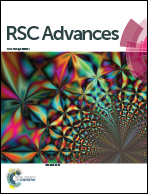Experimental design for simultaneous analysis of malachite green and methylene blue; derivative spectrophotometry and principal component-artificial neural network
Abstract
In this study, oxidized multiwalled carbon nanotubes (MWCNT) with sizes in the range of 10–30 nm were efficiently applied for simultaneous and competitive adsorption of malachite green (MG) and methylene blue (MB). The competitive adsorption of MB and MG was studied following accurate and repeatable monitoring in binary mixtures via second order derivative spectrophotometry (SODS) and a principal component–artificial neural network model (PCA–ANN). The MWCNTs were characterized by different techniques such as TEM, XPS and FTIR. The dyes removal percentages as responses were modeled and optimized versus the variables by central composite design (CCD) under response surface methodology and PCA–ANN. The optimum values of initial MG and MB concentrations, MWCNT mass (g) and sonication time (min) were found to be 14.6 and 10 mg L−1, 0.025 g and 2.6 min, respectively, at which the removal percentages of the dyes were maximum. The advantage of this process is its high removal performance in a very short time using a small amount of MWCNT. Various isotherm models were applied and their suitability for describing the experimental equilibrium data was investigated. It was shown that the Langmuir model is able to predict the real behavior of both dyes in the equilibrium mode with removal percentages of more than 95% and adsorption capacities of 102.3 and 57.6 mg g−1 for MB and MG, respectively.


 Please wait while we load your content...
Please wait while we load your content...